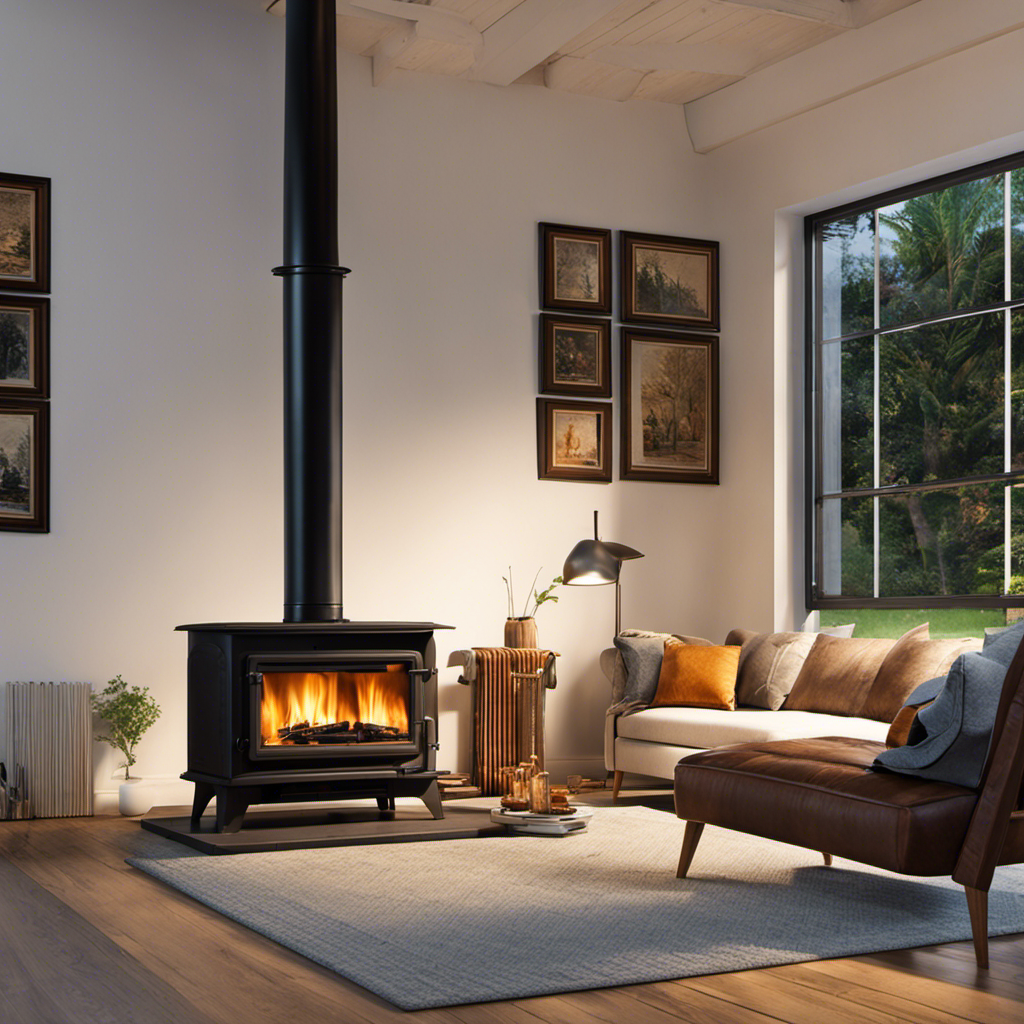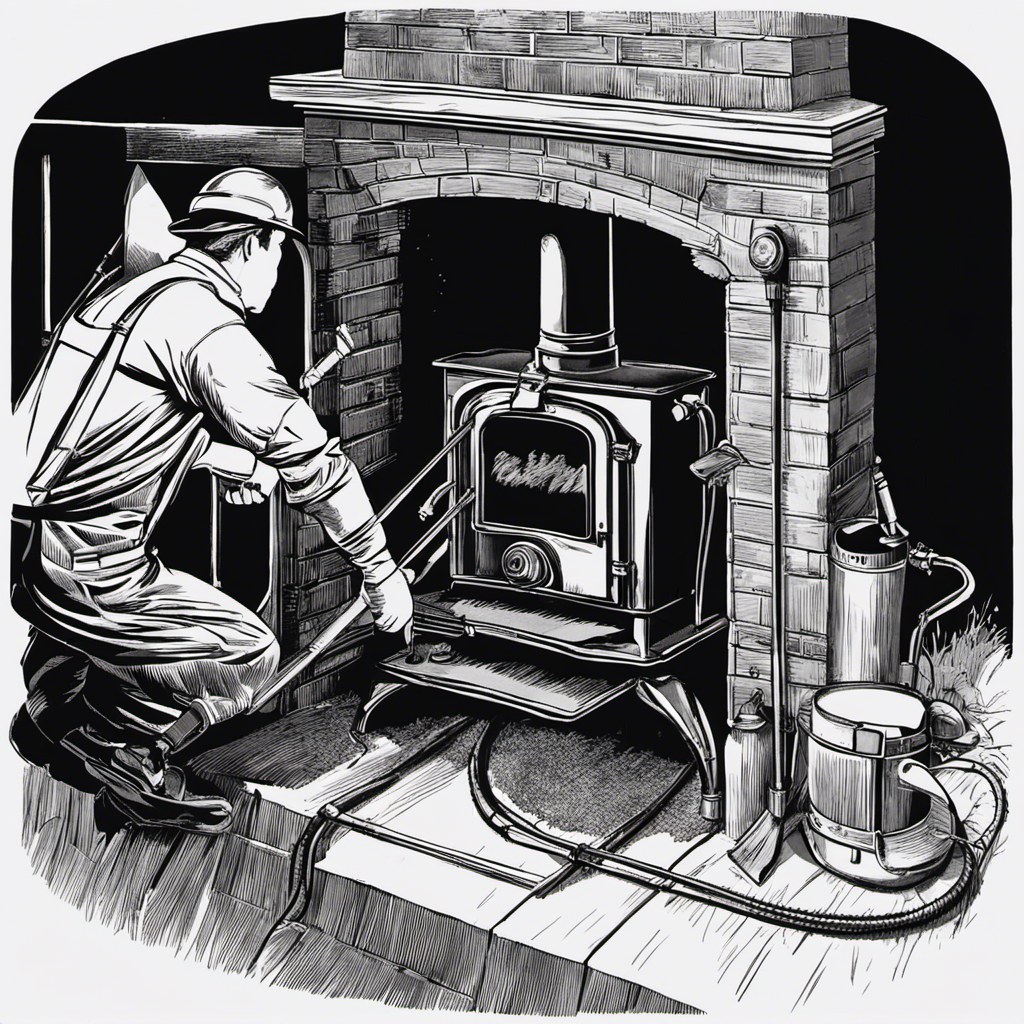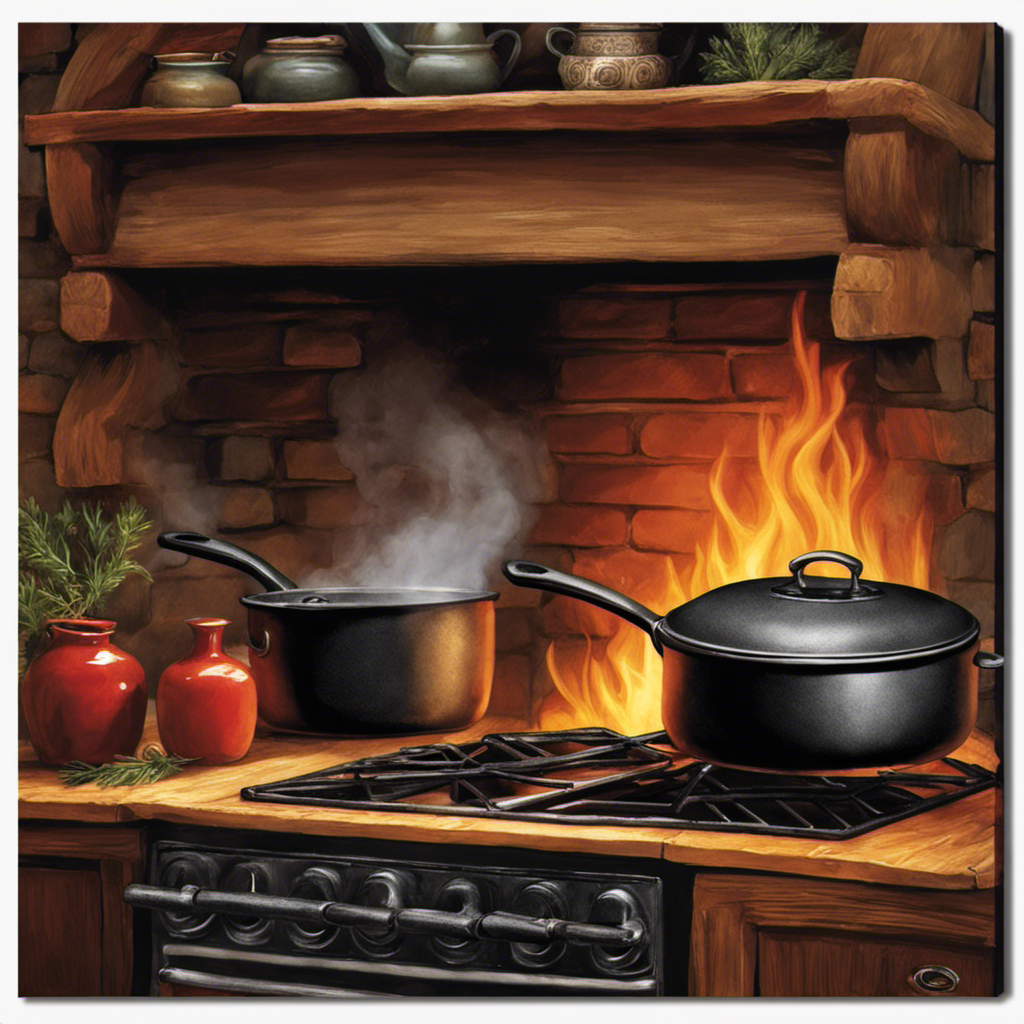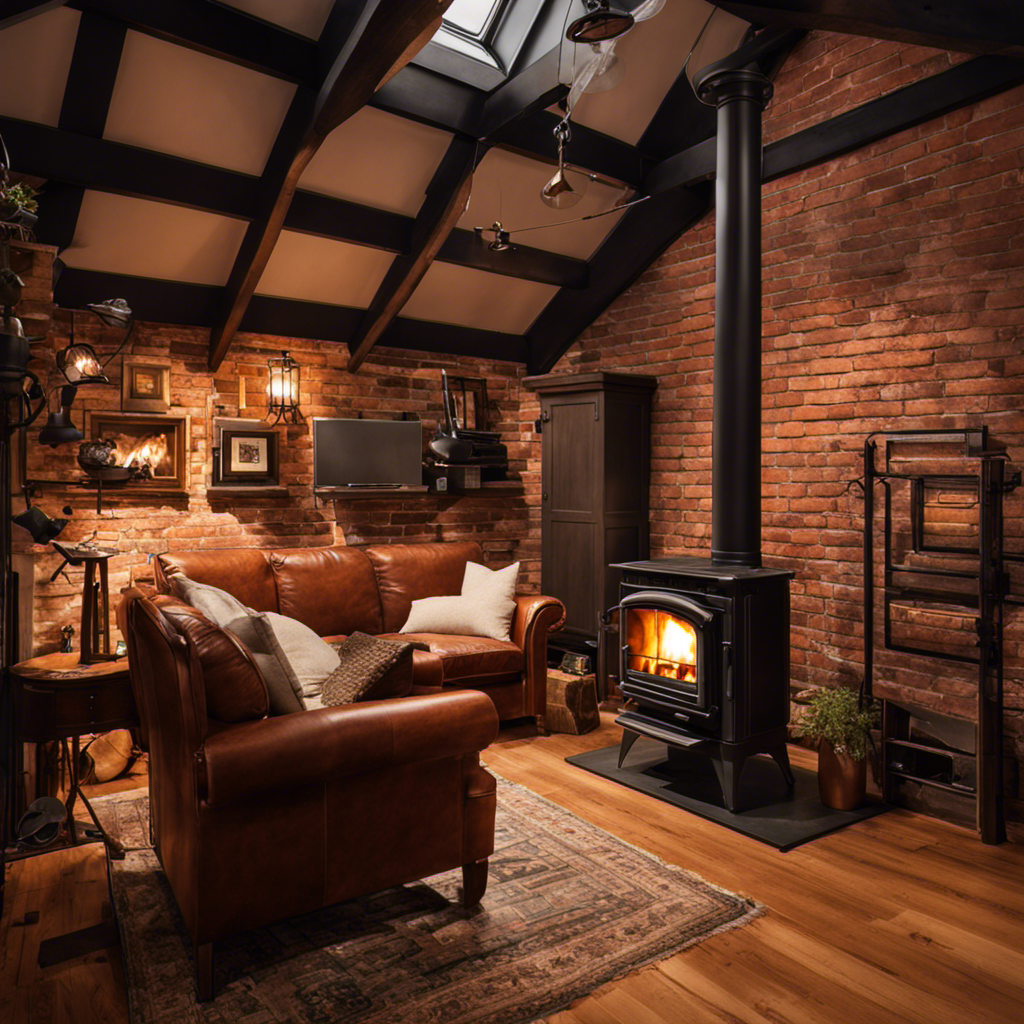I’ve found a dependable technique for effectively dispersing heat from my wood stove, and I’m eager to pass along this knowledge to you.
By understanding heat distribution and utilizing ceiling fans, heat circulation can be greatly improved.
Installing heat transfer systems and maximizing heat flow with ductwork are other effective strategies.
Additionally, there are alternative methods worth exploring.
In this article, I’ll provide step-by-step instructions on how to implement these techniques, ensuring you get the most out of your wood stove’s heat.
Key Takeaways
- Position the wood stove in a central location to maximize heat distribution.
- Install a heat-powered fan on top of the wood stove to circulate warm air.
- Utilize strategic placement of ceiling fans to improve heat circulation.
- Consider installing a heat transfer system with ducts or pipes for more efficient heat distribution throughout the house.
Understanding Heat Distribution
How can I effectively distribute heat throughout my home using a wood stove?
The key to distributing heat from a wood stove is through a combination of heat conduction and heat radiation. Here’s a step-by-step guide on how to achieve optimal heat distribution:
-
Place the wood stove in a central location: Position your wood stove in a central area of your home to maximize heat distribution to all rooms.
-
Use a heat-powered fan: Install a heat-powered fan on top of your wood stove to help circulate warm air throughout the space. These fans operate by converting the heat energy into electricity, which then powers the fan blades.
-
Utilize a heat transfer system: Consider installing a heat transfer system that uses ducts or pipes to distribute hot air from the wood stove to different areas of your home. This can be particularly effective for multi-story houses.
By following these steps, you can ensure efficient heat distribution from your wood stove.
Now, let’s explore how utilizing ceiling fans can further improve heat circulation.
Utilizing Ceiling Fans for Improved Heat Circulation
I find that utilizing ceiling fans and strategically placing them near the wood stove helps improve heat circulation. Here is a step-by-step guide on how to effectively move heat from a wood stove using ceiling fans:
-
Fan Placement:
- Position one ceiling fan above the wood stove, facing downwards. This will help push the rising hot air towards the floor.
- Place another ceiling fan on the opposite side of the room, near a doorway or window. This fan should be set to blow the air towards the stove, creating a circular airflow pattern.
-
Fan Speed Control:
- Set the fan above the wood stove to a higher speed to maximize the airflow and push hot air downwards.
- Adjust the fan near the doorway or window to a lower speed to gently draw in cooler air from outside and mix it with the warm air.
Installing Heat Transfer Systems
Can you recommend any reliable contractors for installing heat transfer systems in homes? Heat transfer systems are a great way to improve heat efficiency in your home. By using various heat transfer techniques, these systems can help distribute heat evenly throughout your house, reducing energy consumption and increasing comfort. When considering the installation of a heat transfer system, it’s important to find a reliable contractor who has experience and expertise in this area. To help you make an informed decision, I have compiled a list of recommended contractors in the table below:
| Contractor | Contact Information |
|---|---|
| ABC Heating Solutions | 555-123-4567 |
| XYZ HVAC Services | 555-987-6543 |
| 123 Heating & Cooling | 555-234-5678 |
These contractors have a proven track record in installing heat transfer systems and are known for their professionalism and quality work. Don’t hesitate to reach out to them for a consultation and quote for your heat transfer system installation.
Maximizing Heat Flow With Ductwork
To maximize heat flow with ductwork, I’ve found that sealing any leaks and insulating the ducts properly can significantly improve the efficiency of my heating system. Here are the steps I take to optimize air flow and maximize heat efficiency:
-
Sealing Leaks:
-
Inspect the ductwork for any visible leaks or gaps.
-
Use duct sealant or foil tape to seal the leaks and gaps.
-
Pay special attention to joints, connections, and corners where leaks are common.
-
Insulating Ducts:
-
Choose insulation material suitable for your ductwork.
-
Wrap the insulation around the ducts, covering them completely.
-
Use insulation tape to secure the insulation in place and prevent air leakage.
Exploring Alternative Heat Transfer Methods
Although I haven’t personally explored alternative heat transfer methods, I’m intrigued by the potential they hold in improving the efficiency of heat transfer in various heating systems. Finding more efficient ways to transfer heat is crucial, especially when considering alternative heat sources. These sources, such as solar or geothermal energy, may have lower heat output compared to traditional fuel sources like gas or oil. Therefore, maximizing heat transfer efficiency becomes even more important. One potential solution is to use heat exchangers. These devices allow for the transfer of heat between two fluids without them mixing. Another option is to utilize phase change materials, which absorb and release heat during phase transitions. By incorporating these alternative heat transfer methods, we can improve the overall efficiency of heating systems and reduce energy consumption.
| Alternative Heat Transfer Methods | Benefits |
|---|---|
| Heat exchangers | – Efficient transfer of heat between fluids – Can be used in various heating systems – Prevents mixing of fluids |
| Phase change materials | – Absorb and release heat during phase transitions – Can store and release heat over longer periods of time – Suitable for applications where continuous heat is required |
| Thermoelectric devices | – Convert temperature differences into electrical energy – Can be used to generate electricity from waste heat – Can improve overall energy efficiency |
| Heat pumps | – Transfer heat from a lower temperature source to a higher temperature sink – Can provide heating and cooling – Can be powered by electricity or other energy sources |
| Forced convection | – Use fans or blowers to enhance heat transfer – Increase the rate of heat transfer between a solid surface and a fluid – Suitable for applications where rapid heat transfer is required, such as in electronics cooling or industrial processes |
Frequently Asked Questions
How Much Does It Cost to Install a Heat Transfer System for a Wood Stove?
Installing a heat transfer system for a wood stove can vary in cost depending on factors such as the type of system and installation complexity. It’s essential to compare costs and consider energy efficiency to make an informed decision.
Can I Use a Heat Transfer System With a Gas or Electric Stove Instead of a Wood Stove?
Yes, you can use a heat transfer system with a gas or electric stove. The benefits of a heat transfer system include distributing heat evenly and reducing energy consumption. However, there are also some cons to consider, such as the initial cost and installation requirements.
Are There Any Safety Precautions I Should Take When Installing a Heat Transfer System?
When installing a heat transfer system, it’s important to prioritize safety measures. Avoid common mistakes by ensuring proper ventilation, securing all connections tightly, and regularly inspecting for any signs of damage or wear.
Can I Use a Heat Transfer System in a Multi-Story House?
Yes, a heat transfer system can be used in a multi-story house. It improves efficiency by distributing heat from the wood stove to other areas. Alternative methods include using fans or installing ductwork to move heat throughout the house.
Are There Any Maintenance Requirements for a Heat Transfer System?
To ensure optimal performance, a heat transfer system requires regular maintenance. This includes cleaning the filters and vents, inspecting for any leaks or damage, and lubricating moving parts. Troubleshooting tips may also be needed to address any issues that arise.
Conclusion
To sum it up, by strategically utilizing ceiling fans, installing heat transfer systems, and maximizing heat flow with ductwork, you can efficiently move the heat from your wood stove throughout your living space.
Exploring alternative heat transfer methods can also provide additional options for distributing heat.
With these techniques, you can ensure a visually pleasing and cozy environment, making the most out of your wood stove’s warmth.











